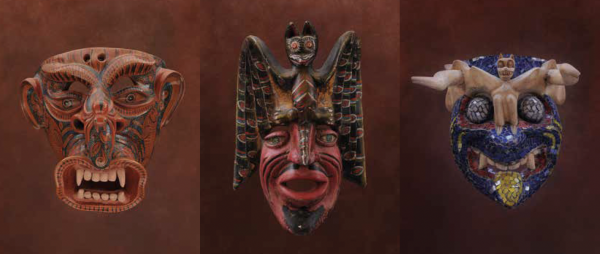Masks Used in Other Contexts
Given their prominence in pre-Hispanic, colonial, and contemporary life, it is not surprising that the symbols, themes, and styles portrayed in masks would become incorporated in other aspects of life in Mexico. Masked superheroes in Mexican film and television are just as popular as they are in the United States. In the sports/entertainment realm, Mexican freestyle wrestlers have adopted wearing masks with the symbols, characteristics, and identities of pre-Hispanic gods and indigenous heroes. When mask-wearing became a part of everyday life for virtually everyone during the COVID-19 pandemic, many protective masks in Mexico incorporated elements from the dance and decorative masks seen in the towns and villages of the country.
Masks In Mexican Freestyle Wrestling
Though steeped in ancient roots, mask wearing spread to a new form of popular culture in Mexico in the 1940s—freestyle wrestling (lucha libre). A wrestler who referred to himself as El Santo (The Saint) wore a silver mask during his bouts in the ring in Mexico City. People immediately were drawn to the mystery of the man behind this mask and for many of the five decades of his career he was the most popular wrestler in the country. El Santo became a folk hero who was pictured in comic books and featured in movies. His popularity gave rise to many other wrestlers adopting stylized masks of animals, warriors, and gods, taking on mysterious personas that are hidden behind the masks. Some wrestlers never appear in public without their masks and there are instances of wrestlers who were buried in their masks. The phenomenon of mask-wearing during wrestling bouts is now commonplace in Mexico from the largest venues to matches occurring in small villages and towns.
“When I put on the mask, I'm transformed. The mask gives me strength. The mask gives me fame. The mask is magical. When I remove the mask, I'm a normal human who can walk right by you, and not even get a "hello." Usually with the mask on, everything is positive. Without the mask I'm a normal being who has his problems, who cries, who sometimes suffers. I could tell you that I really admire El Hijo del Santo. But do you know who I admire more? The human being. Thanks to him, El Hijo del Santo has a life. And this human being sometimes sacrifices a lot to give this other identity life.” - El Hijo del Santo, Mexican Freestyle Wrestler
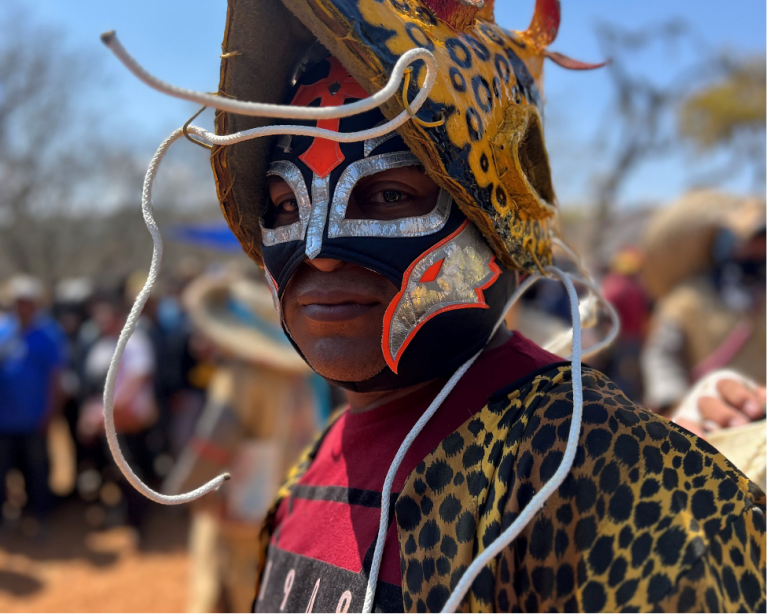 Dancer Wearing a Freestyle Wrestling Mask Under a Tecuanes Mask
Dancer Wearing a Freestyle Wrestling Mask Under a Tecuanes Mask
Acatlán, Guerrero
Photo by Carlos Arturo Hernández Dávila 2023
Mask-making and the COVID Epidemic
The coronavirus epidemic caused disruptions all over the world, and the economic repercussions spread everywhere, including to the Mexican mask-makers. Travel restrictions around COVID meant that local and international tourists were no longer visiting villages and towns where masks were made. Arenas in which lucha libre (freestyle wrestling) matches were held closed to the public, so mask-makers lost this market. Perhaps not surprisingly, some of the individuals who had built a business selling lucha libre masks to fans turned to creating COVID masks. Retired wrestler José Isaías Huerta (who wrestled as the Grey Cat) and current wrestler Hijo del Soberano (Son of the Sovereign) have been featured in articles around the world. They began making and selling COVID masks that featured the same colors and designs of some of the most famous lucha libre stars. Other stories from the pandemic featured lucha libre wrestlers enforcing mask wearing in the central marketplace of Mexico City. They forcibly put a mask on anyone who was not already masked (Mexico: Lucha libre wrestlers enforce covid face masks - YouTube).
 Hijo del Soberano (Son of the Sovereign) Hijo del Soberano (Son of the Sovereign)Making COVID Masks Photo by Armando Marín/Jam Media 2020 |
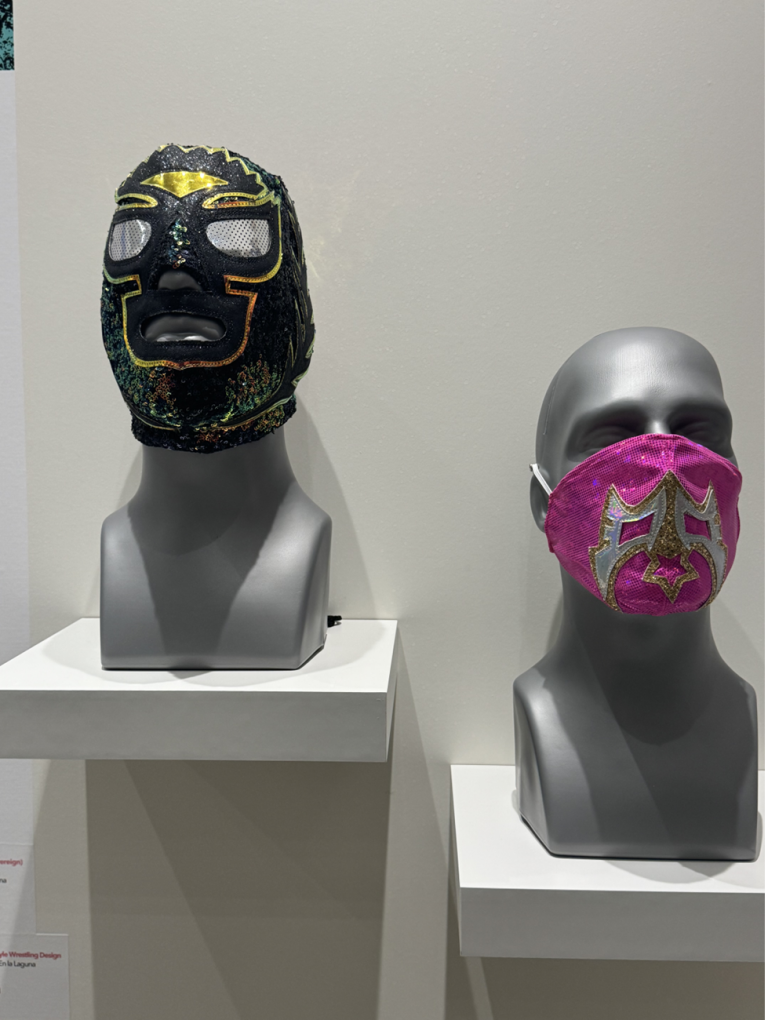 Left: Hijo del Soberano (Son of the Soverign) Freestyle Wrestling Mask Left: Hijo del Soberano (Son of the Soverign) Freestyle Wrestling Mask Artist: Equipos de Lucha en la Laguna (Soberano) Torreon, Coahuila Nylon Fabric, sequins, cotton, vinyl 2020 Right: COVID Mask with Freestyle Wrestling Design Artist: Equipos de Lucha en la Laguna (Soberano) Torreon, Coahuila Nylon Fabric, elastic, vinyl 2020 |
Incorporating the Coronavirus into a New Art Form
Just as the makers of lucha libre masks turned to making COVID masks, some of the artisans who had been producing dance masks and masks for tourists and collectors turned their attention to representing the threat of COVID through their work. Two Mexican anthropologists, Blanca Cárdenas and Carlos Dávila, began to see mask-makers advertising their creations on Facebook and other platforms. They then created the project “Putting a Face on the Virus” and began contacting indigenous artists throughout the country asking them to interpret the agent of the pandemic through their work. They used their own resources to commission the masks and, when they thought it was safe, ventured out to pick up the masks. Even in the context of the fantastic masks created over the centuries, the COVID masks created by these artists are extraordinary.
In the history of Mexico, the most pernicious diseases have been introduced by Europeans or mestizos (mixed blood). The mestizo man mask is the face of a pink-skinned, blue-eyed man who has been aggressively attacked by COVID. The idea of a humanized virus is suggestive, but it is radically an “other” identified with the process of evangelization, subjugation, and colonization of souls since the 16th century in the Americas.
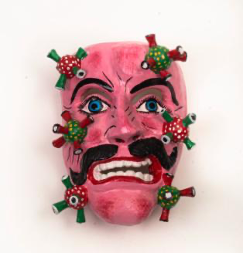 Mestizo (Mixed Blood) Man Mask Artist: Zeferino Baltasar Basilio (Nahua artisan) Mestizo (Mixed Blood) Man Mask Artist: Zeferino Baltasar Basilio (Nahua artisan)San Francisco Ozomatlán, Guerrero Wood, paint 2021 Loan from Sylvia Keller and Bill DeWalt |
 COVID Pig Mask Artist: Zeferino Baltasar Basilio (Nahua artisan) COVID Pig Mask Artist: Zeferino Baltasar Basilio (Nahua artisan)Ozomatlán, Guerrero Materials: Wood, paint, tanned leather ears, pig tusks 2021 Loan from Sylvia Keller and Bill DeWalt |
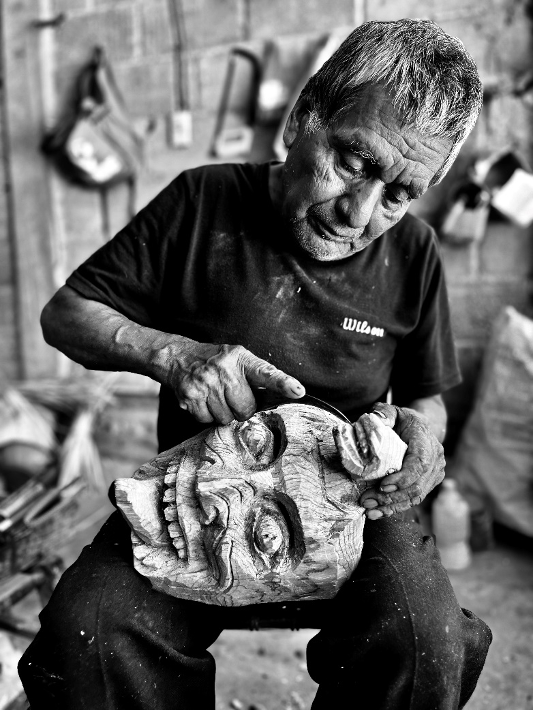 Artist Zeferino Baltasar Basilio (Nahua artisan) Artist Zeferino Baltasar Basilio (Nahua artisan)Photo by Carlos Arturo Hernández Dávila 2021 |
The pig is an animal that came to America as part of the Conquest and, to this day, in many indigenous communities in Mexico it is associated with deadly diseases. Although it is frequently consumed, there are numerous considerations about its cooking and the respect with which the animal should be treated. Therefore, it is not surprising that COVID is identified with the pig, as a potentially dangerous foreign agent.
The Ikoot (or Huave) indigenous communities inhabit the coast of Oaxaca in Mexico. During 2020 they faced numerous social and political disturbances which, accompanied by the pandemic, left a significant number of deaths. In June 2020, 21 people were killed by their neighbors during local clashes. Death as portrayed in this mask is a mixture of human actions and non-human agencies.
Resource: Mexican Artists Create Fantastical Masks To Depict The Many Faces Of COVID : Goats and Soda : NPR
The Misery of COVID
This mask with the huge COVID spikes growing from its face shows the anguish suffered by people with this disease. Rural areas like those in the Mexican state of Hidalgo with large indigenous populations were particularly hard hit by COVID. These places often lack even basic medical care facilities, meaning that those with the disease were left on their own to battle for survival.
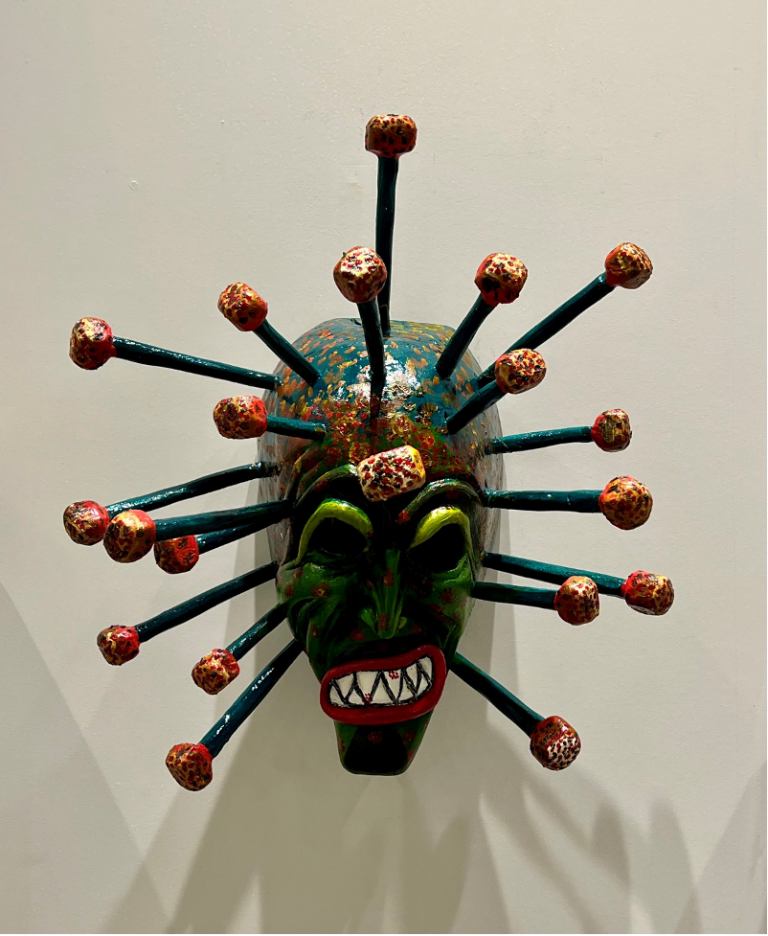 The Misery of Covid Artist: Juan Hernández The Misery of Covid Artist: Juan HernándezHuastec Region of Hidalgo Wood, paint 2023 Loan from Sylvia Keller and Bill DeWalt |
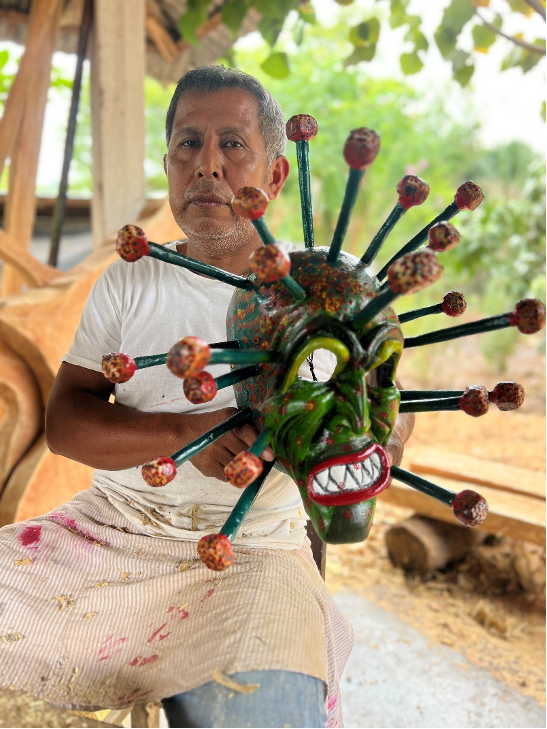 Artist Juan Hernández with the COVID Mask He Created Artist Juan Hernández with the COVID Mask He CreatedPhoto by Carlos Arturo Hernández Dávila 2023 |
 The Mask of Power The Mask of PowerArtist: Diego Victoria Hidalgo (Ikoot artisan) San Mateo del Mar, Oaxaca Wood, paint 2021 Loan from Sylvia Keller and Bill DeWalt |
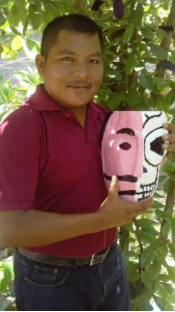 Artist Diego Victoria Hidalgo with the COVID Mask He Created Artist Diego Victoria Hidalgo with the COVID Mask He CreatedPhoto by Carlos Arturo Hernández Dávila 2021 |
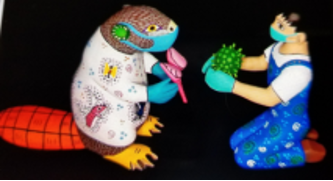 Beaver and Boy Discussing Covid Beaver and Boy Discussing CovidArtist: Armando and Antonia Jimenez Xoxocotlan, Oaxaca Wood, paint 2021 Loan from Lisa DiGioia-Nutini |


